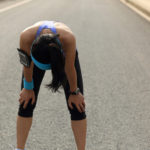Fluid Facts for Athletes
If you are a serious athlete who works up a good sweat, you might have wondered how much you should drink before, during and after a hard workout. According to the American College of Sports Medicine’s latest update on fluid needs for athletes (1), only you can determine that answer because fluid needs vary greatly from person to person.
Here’s what ACSM has to say—
• Sweat rates commonly range between 1 to 4 pounds (0.5 to 2 quarts) per hour, depending on your sport and environmental conditions. Sweat rates for a 110-pound slow runner might be one pound (16 oz) of sweat per hour, while a 200-pound fast runner might lose about four pounds (a half-gallon) per hour. Even fast swimmers sweat—almost a pound per hour of training. Football players might lose more than two gallons of sweat in a day.
Few athletes actually make the effort to learn their sweat rates; they simply drink according to thirst throughout their workout. This can be OK if you are exercising gently for less than an hour. But if you will be sweating bullets for extended exercise, you really should know your sweat rate. Otherwise, you are likely to repeatedly under-hydrate, become chronically dehydrated and hurt your performance.
• To determine if you are adequately hydrating on a daily basis, weigh yourself nude each day in the morning after having emptied your bladder and bowels. Your weight should remain relatively stable and not creep downwards. This weight assumes—
1) you are not restricting calories to lose fat-weight.
2) you have not eaten abnormally high amounts of sodium the night before, such as a water-retaining Chinese dinner.
3) you are not experiencing 2 to 4 pounds of pre-menstrual bloat.
• There’s no need to try to super-hydrate pre-exercise; your body can absorb just so much fluid. If you over-drink, you then may have to (inconveniently) urinate during exercise; the kidneys can only make about 1 quart of urine per hour. A wise tactic is to tank-up two or more hours pre-exercise; this allows time for your kidneys to process and eliminate the excess. Then drink again 5 to 15 minutes pre-exercise.
• Some athletes can tolerate exercising while dehydrated better than others. But most athletes who lose >2% of their body weight in sweat losses lose both their mental edge and their physical ability to perform well, especially if the weather is hot. Yet during cold weather, you are less likely to experience reduced performance even at 3% dehydration (4.5 lbs sweat loss for a 150 lb athlete). Dehydration (3-5%) does not seem to impact either muscle strength or anaerobic performance. Yet, sweat loss of 9% to 12% body weight can lead to death!
• If you become more than 7% dehydrated (either by sweat losses, diarrhea or vomiting), you will likely end up with a doctor introducing intravenous fluid replacement. In most cases, there is no advantage to taking fluids by IV, unless for medical necessity. But please, stay out of the medical tent by knowing your sweat rate and drinking accordingly!!!
• If you become significantly dehydrated and have to exercise again within 12 hours, such as during a tennis tournament or triathlon training, you need to aggressively rehydrate. This means drinking 50% more fluid than your sweat losses (to account for the water you lose via urine.) Sipping fluids for several hours after you exercise maximizes fluid retention and is preferable to gulping one big drink.
• Sweat contains more than just water; it has electrically charged particles that help keep water in the right balance inside and outside of cells.
| Electrolyte | Average amount/2 lbs* sweat | Food reference |
| Sodium | 800 mg (range 200-1,600) | 1 quart Gatorade = 440 mg Sodium |
| Potassium | 200 mg (range 120-600) | 1 med banana = 450 mg Potassium |
| Calcium | 20 mg (range 6-40) | 8 oz yogurt = 300 mg Calcium |
| Magnesium | 10 mg (range 2-18) | 2 Tbsp peanut butter = 50 mg Mg |
*=(1 liter,~1 quart)
• Dehydration is more common than over-hydration, but over-hydration to the point of hyponatremia (low blood sodium) is very dangerous and can escalate into seizures, coma and death. The symptoms (that become increasingly severe), include headache, vomiting, swollen hands and feet, undue fatigue, confusion (due to progressive swelling of water in the brain) and wheezing (due to water in the lungs).
• In general, hyponatremia that occurs in events that last for less than 4 hours is from overdrinking water before, during and even after the event. Don’t drink more than you sweat; learn your sweat rate!
• Hyponatremia that occurs in ultra-endurance events that last for more than four hours is often related to extreme sodium losses. Hence, with extended exercise, be sure to replace sodium losses with more than just sports drinks. (Sports drinks generally contain too little sodium to balance sweat loss.) Choose ENDURANCE sports drinks and salty snacks such as pretzels, V-8 juice, soup, olives, salt sprinkled on foods, and even salt tablets.
• You are likely to maintain better hydration if you have easy access to good tasting beverages before, during and after exercise. “Good tasting” means:
– a cool temperature (most athletes prefer between 60-70° F)
– a little sodium
– an appealing flavor. (What makes a flavor “appealing” varies greatly between people, cultures).
• Muscle cramps are believed to be associated with dehydration, electrolyte deficits and muscle fatigue. If you sweat profusely, are left caked with salt, and experience cramps, take extra care to drink plenty of sodium-containing fluids while exercising. Because of the high salt content of the standard American diet, you can likely replace sodium losses during meals without sodium supplements. But consuming extra salt on your food if you had high sweat losses can be a smart way to enhance recovery, retain fluid and stimulate thirst.
• If you like a caffeine-boost pre-exercise to enhance your performance, rest assured caffeine (in small doses; <180 mg/day, a 12-oz mug) is unlikely to increase your daily urine output nor cause you to become dehydrated. Enjoy it, if desired!
More information on caffeine and the athlete can be found in the following SportsMD article.
• Alcohol, on the other hand, does have a diuretic effect, particularly in large amounts. After exercise, consume alcohol only in moderation, if at all, with lots of extra water (plus some carbs to buffer the alcohol and refuel the muscles).
• When you are exercising hard for more than an one hour (or doing less intense, longer exercise), adding 120 to 240 calories of carbohydrates (30-60 g) per hour to your water can help you perform better. These carbs help maintain normal blood glucose levels so you are able to enjoy sustained energy. Sports drinks are an easy way to get carbs + water; for example, 16 ounces of Gatorade offers 25 g carb; 16 oz, Powerade, 140 cals, 35 g carb.
The bottom line
For athletes, the saying “Drink responsibly” holds true for all fluids (alcohol-containing or not). Don’t let dehydration—or over-hydration—hurt your ability to enjoy exercise and perform at your best.
Nancy Clark, MS, RD, CSSD (Board Certified Specialist in Sports Dietetics) counsels casual and competitive athletes in her private practice at Healthworks, the premier fitness center is Chestnut Hill MA (617-383-6100). For fueling help, read her bestselling Sports Nutrition Guidebook and food guides for new runners, marathoners or soccer players. See www.nancyclarkrd.com and sportsnutritionworkshop.com for information about upcoming and online workshops.
Reference
American College of Sports Medicine Position Stand: Exercise and Fluid Replacement. Medicine and Science in Sports and Exercise, 39 (2):377-390, February 2007





